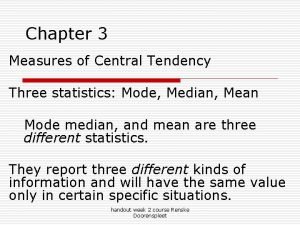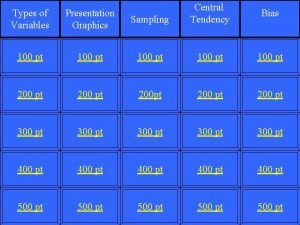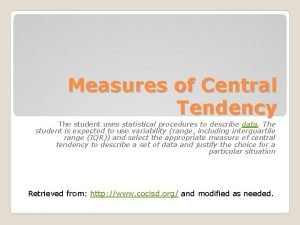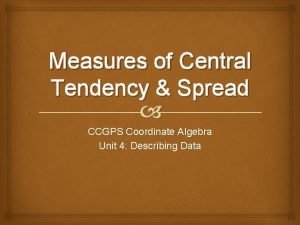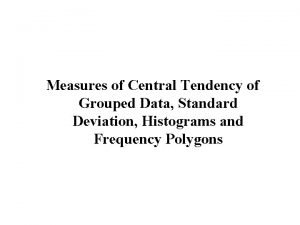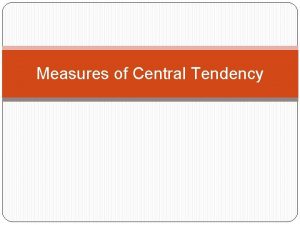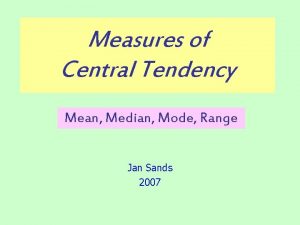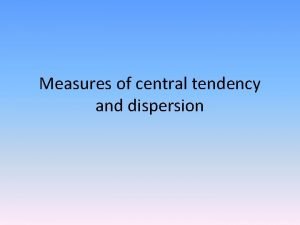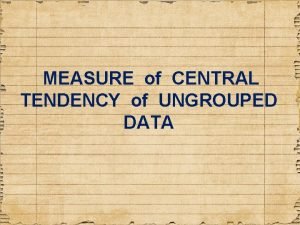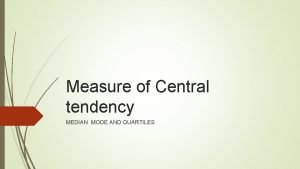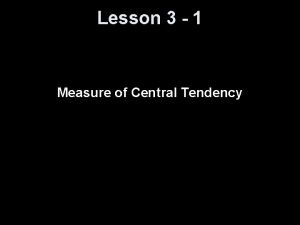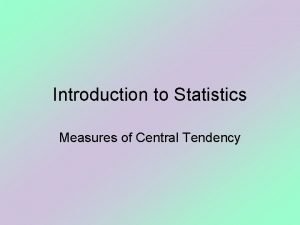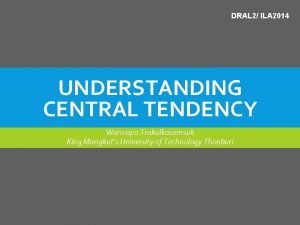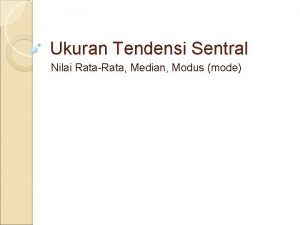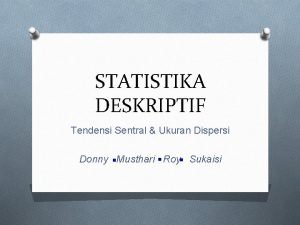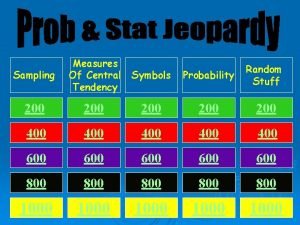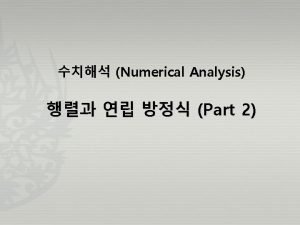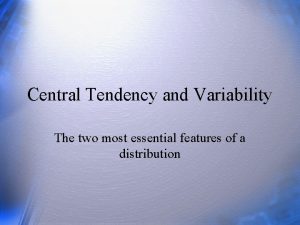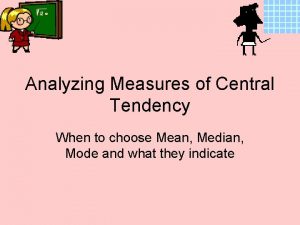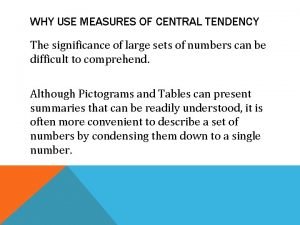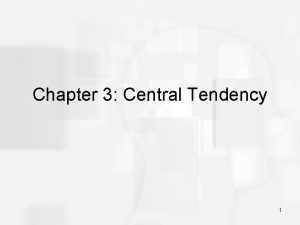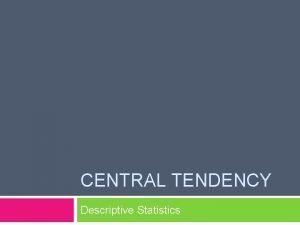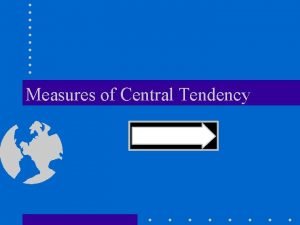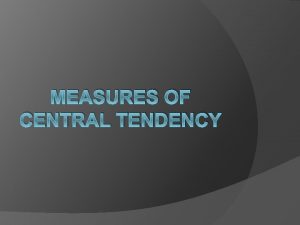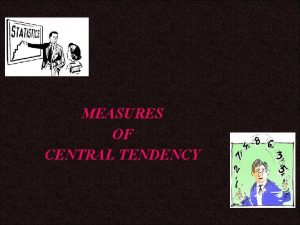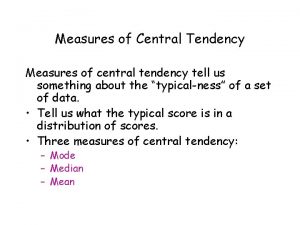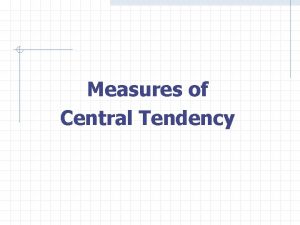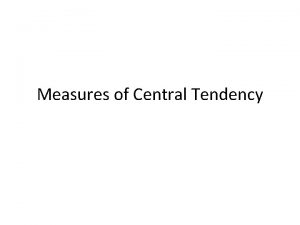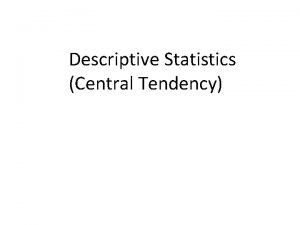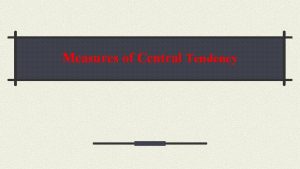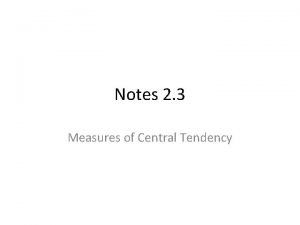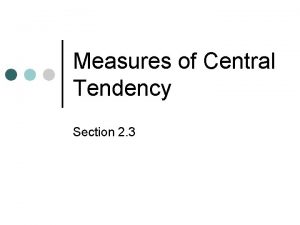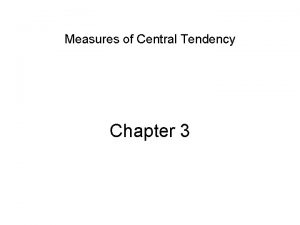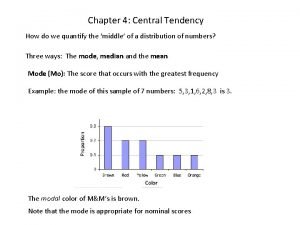Chapter 3 Central Tendency 1 Central Tendency In


























- Slides: 26

Chapter 3: Central Tendency 1

Central Tendency • In general terms, central tendency is a statistical measure that determines a single value that accurately describes the center of the distribution and represents the entire distribution of scores. • The goal of central tendency is to identify the single value that is the best representative for the entire set of data. 2

Central Tendency (cont. ) • By identifying the "average score, " central tendency allows researchers to summarize or condense a large set of data into a single value. • Thus, central tendency serves as a descriptive statistic because it allows researchers to describe or present a set of data in a very simplified, concise form. • In addition, it is possible to compare two (or more) sets of data by simply comparing the average score (central tendency) for one set versus the average score for another set. 3

4

The Mean, the Median, and the Mode • It is essential that central tendency be determined by an objective and well‑defined procedure so that others will understand exactly how the "average" value was obtained and can duplicate the process. • No single procedure always produces a good, representative value. Therefore, researchers have developed three commonly used techniques for measuring central tendency: the mean, the median, and the mode. 5

The Mean • The mean is the most commonly used measure of central tendency. • Computation of the mean requires scores that are numerical values measured on an interval or ratio scale. • The mean is obtained by computing the sum, or total, for the entire set of scores, then dividing this sum by the number of scores. 6

The Mean (cont. ) Conceptually, the mean can also be defined as: 1. The mean is the amount that each individual receives when the total (ΣX) is divided equally among all N individuals. 2. The mean is the balance point of the distribution because the sum of the distances below the mean is exactly equal to the sum of the distances above the mean. 7

8

Changing the Mean • Because the calculation of the mean involves every score in the distribution, changing the value of any score will change the value of the mean. • Modifying a distribution by discarding scores or by adding new scores will usually change the value of the mean. • To determine how the mean will be affected for any specific situation you must consider: 1) how the number of scores is affected, and 2) how the sum of the scores is affected. 9

Changing the Mean (cont. ) • If a constant value is added to every score in a distribution, then the same constant value is added to the mean. Also, if every score is multiplied by a constant value, then the mean is also multiplied by the same constant value. 10

When the Mean Won’t Work • Although the mean is the most commonly used measure of central tendency, there are situations where the mean does not provide a good, representative value, and there are situations where you cannot compute a mean at all. • When a distribution contains a few extreme scores (or is very skewed), the mean will be pulled toward the extremes (displaced toward the tail). In this case, the mean will not provide a "central" value. 11

When the Mean Won’t Work (cont. ) • With data from a nominal scale it is impossible to compute a mean, and when data are measured on an ordinal scale (ranks), it is usually inappropriate to compute a mean. • Thus, the mean does not always work as a measure of central tendency and it is necessary to have alternative procedures available. 12

The Median • If the scores in a distribution are listed in order from smallest to largest, the median is defined as the midpoint of the list. • The median divides the scores so that 50% of the scores in the distribution have values that are equal to or less than the median. • Computation of the median requires scores that can be placed in rank order (smallest to largest) and are measured on an ordinal, interval, or ratio scale. 13

The Median (cont. ) Usually, the median can be found by a simple counting procedure: 1. With an odd number of scores, list the values in order, and the median is the middle score in the list. 2. With an even number of scores, list the values in order, and the median is half-way between the middle two scores. 14

15

The Median (cont. ) • If the scores are measurements of a continuous variable, it is possible to find the median by first placing the scores in a frequency distribution histogram with each score represented by a box in the graph. • Then, draw a vertical line through the distribution so that exactly half the boxes are on each side of the line. The median is defined by the location of the line. 16

17

The Median (cont. ) • One advantage of the median is that it is relatively unaffected by extreme scores. • Thus, the median tends to stay in the "center" of the distribution even when there a few extreme scores or when the distribution is very skewed. In these situations, the median serves as a good alternative to the mean. 18

The Mode • The mode is defined as the most frequently occurring category or score in the distribution. • In a frequency distribution graph, the mode is the category or score corresponding to the peak or high point of the distribution. • The mode can be determined for data measured on any scale of measurement: nominal, ordinal, interval, or ratio. 19

The Mode (cont. ) • The primary value of the mode is that it is the only measure of central tendency that can be used for data measured on a nominal scale. In addition, the mode often is used as a supplemental measure of central tendency that is reported along with the mean or the median. 20

Bimodal Distributions • It is possible for a distribution to have more than one mode. Such a distribution is called bimodal. (Note that a distribution can have only one mean and only one median. ) • In addition, the term "mode" is often used to describe a peak in a distribution that is not really the highest point. Thus, a distribution may have a major mode at the highest peak and a minor mode at a secondary peak in a different location. 21

22

Central Tendency and the Shape of the Distribution • Because the mean, the median, and the mode are all measuring central tendency, the three measures are often systematically related to each other. • In a symmetrical distribution, for example, the mean and median will always be equal. 23

Central Tendency and the Shape of the Distribution (cont. ) • If a symmetrical distribution has only one mode, the mode, mean, and median will all have the same value. • In a skewed distribution, the mode will be located at the peak on one side and the mean usually will be displaced toward the tail on the other side. • The median is usually located between the mean and the mode. 24

Reporting Central Tendency in Research Reports • In manuscripts and in published research reports, the sample mean is identified with the letter M. • There is no standardized notation for reporting the median or the mode. • In research situations where several means are obtained for different groups or for different treatment conditions, it is common to present all of the means in a single graph. 25

Reporting Central Tendency in Research Reports (cont. ) • The different groups or treatment conditions are listed along the horizontal axis and the means are displayed by a bar or a point above each of the groups. • The height of the bar (or point) indicates the value of the mean for each group. Similar graphs are also used to show several medians in one display. 26
 Statistics chapter 3 measures of central tendency
Statistics chapter 3 measures of central tendency Central tendancy bias
Central tendancy bias Measures of central tendency
Measures of central tendency Central tendency and spread homework
Central tendency and spread homework Measures of central location for grouped data
Measures of central location for grouped data Objective of central tendency
Objective of central tendency How to calculate mode for grouped data
How to calculate mode for grouped data Measures of central tendency range
Measures of central tendency range Measure of central tendency and dispersion
Measure of central tendency and dispersion Central tendency of ungrouped data
Central tendency of ungrouped data Measure of central tendency
Measure of central tendency Objectives of central tendency
Objectives of central tendency Measures of central tendency
Measures of central tendency Grouped data mean
Grouped data mean Use of central tendency
Use of central tendency Central tendency
Central tendency Example of measure of central tendency
Example of measure of central tendency Contoh tendensi sentral
Contoh tendensi sentral Tendensi sentral
Tendensi sentral Central tendency symbols
Central tendency symbols Pengukuran tendensi sentral
Pengukuran tendensi sentral Nxn 역행렬 알고리즘
Nxn 역행렬 알고리즘 Central tendency and variation
Central tendency and variation Central tendency and variability
Central tendency and variability Central tendency worksheet
Central tendency worksheet Importance of central tendency
Importance of central tendency Median
Median
